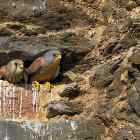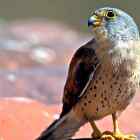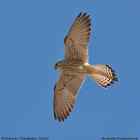The European Commission has approved the financing of the LIFE Project entitled ZEPAURBAN, i.e. the “Management of urban ZEPAs for the conservation of the lesser kestrel in Extremadura” with a total amount of 2,779,810€ and which will be carried out over the next 4 years.
The project, which is led by the State Office for the Environment, will be carried out by the State Tourism Office and the State Office of Libraries, Museums, and the Cultural Heritage and other collaborating partners such as the Technological Institute for Ornamental Rocks and Building Materials (Instituto Tecnológico de Rocas Ornamentales y Materiales de Construcción, INTROMAC), the associations DEMA and Terra Naturalis, the Universidad de Extremadura, and the companies Laruinagrafica S.L. and Prefabricados Extremadura 2002 S.L.
The objective of said project will be the development of a management model for the urban Special Bird Protection Areas (Zonas de Especial Protección para las Aves, ZEPAs) of Extremadura to ensure the long-term conservation of the lesser kestrel, adopting means of conservation to reduce or eliminate its main threats in urban habitats and enhancing the value of this species with socioeconomic resources at a local level.
The means of conservation include in particular work planned on various buildings, most of which are of great heritage value, to improve the nesting sites of the lesser kestrel by means of the installation of nest boxes or the adaptation of putlog holes. Protocols will also be established for avoiding the destruction and disturbance of colonies as a consequence of the restoration of historic buildings or owing to work to maintain roofs, integrating these measures in the town planning regulations of the municipalities for urban ZEPAs.
With the aim of becoming more familiar with their feeding habitat, birds will be fitted with transmitters and a pilot experiment will be carried out by means of collaboration agreements with farmers and stockbreeders so as to apply certain measures to pastures, crops, and borders to encourage the species.
Another important objective will be making the local population aware of the conservation problems of the species and achieving its involvement in order to solve them, with various forms of action being anticipated such as agreements with owners, meetings and talks aimed at the local population, training workshops for construction companies, the installation of webcams, and the publication of manuals, videos, and varied information material.
The urban ZEPAs of Extremadura constitute areas of great heritage and cultural value in which lesser kestrel colonies are to be found on churches, convents, palaces, castles, monasteries, and old houses. For this reason the project also concentrates its efforts on the creation of new tourist products to combine cultural and ornithological tourism, encouraging the economic activity of local companies.
Urban ZEPAs for the lesser kestrel in Extremadura
The autonomous region of Extremadura has been a pioneer in the European Union in the integration of built-up areas in the Natura 2000 network and is the only European region that has declared ZEPAs in the towns containing the major breeding colonies of the lesser kestrel (Falco naumanni). The ZEPAs associated with built-up areas have become one of the distinctive features of the Natura 2000 network in Extremadura as they represent almost 30% of all the ZEPAs in the region (71 sites).
Extremadura currently has 19 urban ZEPAs for the conservation of the lesser kestrel, which include part of the towns of Almendralejo, Acedera, Alburquerque, Belvís de Monroy, Brozas, Cáceres, Fuente de Cantos, Garrovillas, Guareña, Jaraíz de la Vera, Jerez de los Caballeros, Llerena, Plasencia, Ribera del Fresno, San Vicente de Alcántara, Saucedilla, Trujillo, and Zafra. Urban ZEPAs account for over 60% of the entire population of lesser kestrel in the Natura 2000 network, which makes them of crucial importance for the conservation of this threatened species.
About the lesser kestrel
The lesser kestrel (Falco naumanni) is a small diurnal migratory bird of prey that occupies regions with warm climates with the presence of more or less natural steppes and crop areas throughout the Palaearctic region. It prefers to feed in stockbreeding or agricultural areas with a predominance of unirrigated crops, borders, uncultivated land, fallow land, and stubble on large insects (in particular crickets and beetles) and to a lesser extent on micromammals (mice, voles), birds, and lizards.
It is a colonial species that is associated with urban areas in the breeding season, installing its nests in various types of buildings, preferably in holes in walls, putlog holes, or below tiles. This makes it easy to find in both constructions in the country and in built-up areas.
It was formerly one of the most abundant birds of prey in Europe, but its population dropped sharply over the whole of the western Palaearctic as from the second half of the 20th century. The European lesser kestrel population is estimated at between 30,500 and 38,000 pairs. Spain plays an essential role in the conservation of the species as it is the country with the largest breeding population in Europe with some 14,000 pairs. The data collected as from the second half of the 20th century indicate that Extremadura holds somewhat over 20% of the Spanish population which is somewhat over 10% of the European population and shows the great importance of the Extremadura population on a European scale.
The lesser kestrel is included on Annex I of the Bird Directive while in Extremadura the species is listed as “Sensitive to the alteration of its habitat” in the Regional Catalogue of Threatened Species in Extremadura (Decree 37/2001 of 6th March).
Link to Europapress news item: https://goo.gl/Nlsko1







